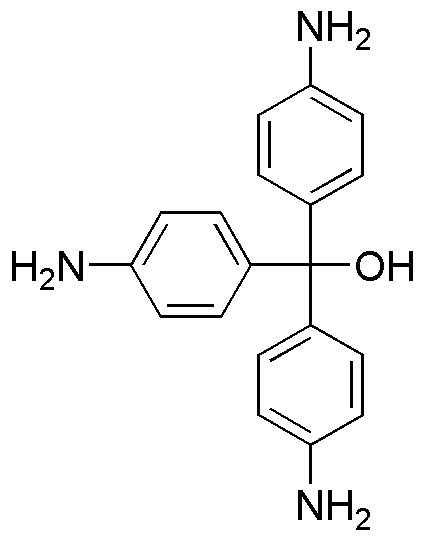Pararosaniline base is widely utilized in research focused on:
- Textile Industry: It serves as a dye in the textile sector, providing vibrant colors to fabrics. Its stability and colorfastness make it a preferred choice for dyeing processes.
- Biological Staining: In microbiology and histology, it is used as a staining agent to enhance the visibility of cellular structures under a microscope, aiding in research and diagnostics.
- Analytical Chemistry: This compound is employed in various analytical techniques, including spectrophotometry, to quantify substances in a sample, making it valuable for quality control in laboratories.
- Pharmaceuticals: Pararosaniline base is used in the synthesis of certain pharmaceutical compounds, contributing to the development of medications with specific therapeutic properties.
- Research and Development: It is a key reagent in organic synthesis, facilitating the creation of complex molecules in research settings, particularly in the development of new materials and chemicals.
General Information
Properties
Safety and Regulations
Applications
Pararosaniline base is widely utilized in research focused on:
- Textile Industry: It serves as a dye in the textile sector, providing vibrant colors to fabrics. Its stability and colorfastness make it a preferred choice for dyeing processes.
- Biological Staining: In microbiology and histology, it is used as a staining agent to enhance the visibility of cellular structures under a microscope, aiding in research and diagnostics.
- Analytical Chemistry: This compound is employed in various analytical techniques, including spectrophotometry, to quantify substances in a sample, making it valuable for quality control in laboratories.
- Pharmaceuticals: Pararosaniline base is used in the synthesis of certain pharmaceutical compounds, contributing to the development of medications with specific therapeutic properties.
- Research and Development: It is a key reagent in organic synthesis, facilitating the creation of complex molecules in research settings, particularly in the development of new materials and chemicals.
Documents
Safety Data Sheets (SDS)
The SDS provides comprehensive safety information on handling, storage, and disposal of the product.
Product Specification (PS)
The PS provides a comprehensive breakdown of the product’s properties, including chemical composition, physical state, purity, and storage requirements. It also details acceptable quality ranges and the product's intended applications.
Certificates of Analysis (COA)
Search for Certificates of Analysis (COA) by entering the products Lot Number. Lot and Batch Numbers can be found on a product’s label following the words ‘Lot’ or ‘Batch’.
*Catalog Number
*Lot Number
Certificates Of Origin (COO)
This COO confirms the country where the product was manufactured, and also details the materials and components used in it and whether it is derived from natural, synthetic, or other specific sources. This certificate may be required for customs, trade, and regulatory compliance.
*Catalog Number
*Lot Number
Safety Data Sheets (SDS)
The SDS provides comprehensive safety information on handling, storage, and disposal of the product.
DownloadProduct Specification (PS)
The PS provides a comprehensive breakdown of the product’s properties, including chemical composition, physical state, purity, and storage requirements. It also details acceptable quality ranges and the product's intended applications.
DownloadCertificates of Analysis (COA)
Search for Certificates of Analysis (COA) by entering the products Lot Number. Lot and Batch Numbers can be found on a product’s label following the words ‘Lot’ or ‘Batch’.
*Catalog Number
*Lot Number
Certificates Of Origin (COO)
This COO confirms the country where the product was manufactured, and also details the materials and components used in it and whether it is derived from natural, synthetic, or other specific sources. This certificate may be required for customs, trade, and regulatory compliance.


